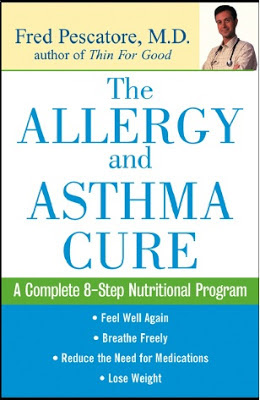The Allergy and Asthma Cure PDF EBOOK
Asthma (from the Greek ἅσθμα, ásthma, "panting") is a common chronic inflammatory disease of the airways characterized by variable and recurring symptoms, reversible airflow obstruction, and bronchospasm. Common symptoms include wheezing, coughing, chest tightness, and shortness of breath.Asthma is thought to be caused by a combination of genetic and environmental factors. Its diagnosis is usually based on the pattern of symptoms, response to therapy over time, and spirometry. It is clinically classified according to the frequency of symptoms, forced expiratory volume in one second (FEV1), and peak expiratory flow rate. Asthma may also be classified as atopic (extrinsic) or non-atopic (intrinsic) where atopy refers to a predisposition toward developing type 1 hypersensitivity reactions. Treatment of acute symptoms is usually with an inhaled short-acting beta-2 agonist (such as salbutamol) and oral corticosteroids. In very severe cases intravenous corticosteroids, magnesium sulfate and hospitalization maybe required. Symptoms can be prevented by avoiding triggers, such as allergens and irritants, and by the use of inhaled corticosteroids. Long-acting beta agonists (LABA) or leukotriene antagonists may be used in addition to inhaled corticosteroids if asthma symptoms remain uncontrolled. The prevalence of asthma has increased significantly since the 1970s. As of 2011, 235–300 million people were affected globally, including about 250,000 deaths. Asthma is characterized by recurrent episodes of wheezing, shortness of breath, chest tightness, and coughing. Sputum may be produced from the lung by coughing but is often hard to bring up. During recovery from an attack it may appear pus like due to high levels of white blood cells called eosinophils. Symptoms are usually worse at night and in the early morning or in response to exercise or cold air. Some people with asthma rarely experience symptoms, usually in response to triggers, whereas others may have marked and persistent symptoms. A number of other health conditions occur more frequently in those with asthma including: gastro-esophageal reflux disease (GERD), rhinosinusitis, and obstructive sleep apnea. Psychological disorders are also more common with anxiety disorders occurring in between 16–52% and mood disorders in 14–41%. It however is not known if asthma causes psychological problems or if psychological problems lead to asthma. Asthma is caused by a combination of complex and incompletely understood environmental and genetic interactions. These factors influence both its severity and its responsiveness to treatment. It is believed that the recent increased rates of asthma are due to changing epigenetics (heritable factors other than those related to the DNA sequence) and a changing living environment. Many environmental factors have been associated with asthma's development and exacerbation including: allergens, air pollution, and other environmental chemicals. Smoking during pregnancy and after delivery is associated with a greater risk of asthma-like symptoms. Low air quality, from traffic pollution or high ozone levels, has been associated with both asthma development and increased asthma severity. Exposure to indoor volatile organic compounds may be a trigger for asthma; formaldehyde exposure, for example, has a positive association. Also, phthalates in PVC are associated with asthma in children and adults as are high levels of endotoxin exposure.Asthma is associated with exposure to indoor allergens.Common indoor allergens include: dust mites, cockroaches, animal dander, and mold. Efforts to decrease dust mites have been found to be ineffective. Certain viral respiratory infections may increase the risk of developing asthma when acquired as young children such as: respiratory syncytial virus and rhinovirus. Certain other infections however may decrease the risk. (wikipedia)
-->
-->



